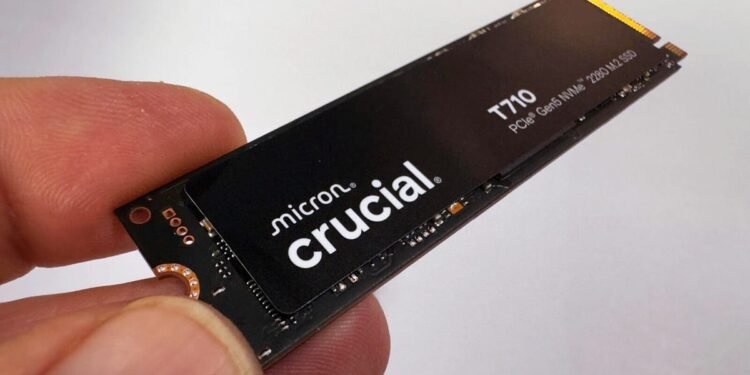
Crucial T710 Gen5 NVMe SSD
ZDNET’s key takeaways
- Loopy quick drive, with reads and writes as much as 14,900 and 13,800MB/s, respectively
- It does get heat in use, so that you may must fixe PC airflow or use a cooler
- You want the correct system to make the most of the Gen5 efficiency that this drive has to supply
Comply with ZDNET: Add us as a preferred source on Google.
Storage has all the time been a bottleneck when it comes to efficiency, and it is a demand-driven factor. As storage will get quicker, so do the pressures placed on it. That is why Fifth-generation NVMe SSDs are such a game-changer for severe avid gamers who want all of the velocity they will get and pro-grade content material creators, particularly those that deal with 100GB-plus information.
Additionally: The best M.2 SSDs you can buy
These drives supply twice the efficiency of the previous-generation {hardware}, and so they’ve now been round for a bit, so costs have come down.
A great instance of that is the Crucial T710. This drive is a beast — so long as you may have a system that may deal with it.
The very first thing that anybody fascinated by upgrading to a Gen5 NVMe SSD wants to think about is whether or not their system can deal with the drive. Whereas it’s backward-compatible with older Gen4 and Gen3 programs, you will not get the efficiency.
To utilize a Gen5 drive, you may want an AMD Ryzen 7000 collection or later or an Intel 12th, 13th or 14th generation Core processor. Moreover, you may want that paired with a motherboard with an AMD X670E, X670, B650E, or Intel Z890, Z790, and Z690 chipset.
When you have that sorted, you are able to go.
Additionally: Why I no longer recommend pre-built SSDs for Windows PCs – and what you should buy instead
The Essential T710 2280 M.2 SSD is about as quick as they get. On paper, it is rated for sequential reads and writes as much as 14,900 and 13,800MB/s, respectively. I’ve benchmarked a drive from this vary and received outcomes inside 5% of those figures (properly, no less than I did as soon as I up to date the system’s firmware to repair a efficiency concern).
The drive helps AES-256 encryption and has a TBW (terabytes written) ranking between 600TB and 2400TB (the bigger the drive, the larger the ranking), and comes with a 5-year restricted guarantee.
A truth of life about operating Gen5 NVMe SSDs is that they run heat to sizzling. And the tougher you’re employed them, the warmer they get. This is not often an issue — it definitely wasn’t for me when testing the T710 — but when your case has poor airflow or all of the followers are choked up with grime, you may need to kind that out or, on the very least, use a cooler.
When you have the room in your system, you should utilize a basic passive cooler, one thing a bit more fancy, or something really fancy (which continues to be lower than $30).
Additionally: This underwater action cam captured my Hawaii trip in ways I didn’t think possible
Each time I point out Gen5 NVMe SSDs, somebody all the time asks me about exterior enclosures’ help for this. Enclosures do exist — take the Acasis 80Gbps M.2 NVMe SSD enclosure — however you are going to pay round $200, and even with Thunderbolt 5 help on the system it is related to, efficiency goes to degree out at round 6,000MB/s. That is good, however it leaves lots within the tank unused.
ZDNET’s shopping for recommendation
The T710 is definitely value contemplating for a system that may deal with Gen5 NVMe SSDs. Its efficiency and worth are distinctive.
The Essential T710 is obtainable in 1TB, 2TB, and 4TB configurations. And proper now, costs are unbelievably good with 17% off the 1TB version, bringing that all the way down to $200, 18% off the 2TB version, now solely $294, and a massive 35% off the 4TB version, bringing it down from $660 to solely $430.
These are costs which are very onerous to beat, and the type of factor that makes me sit up and concentrate.





